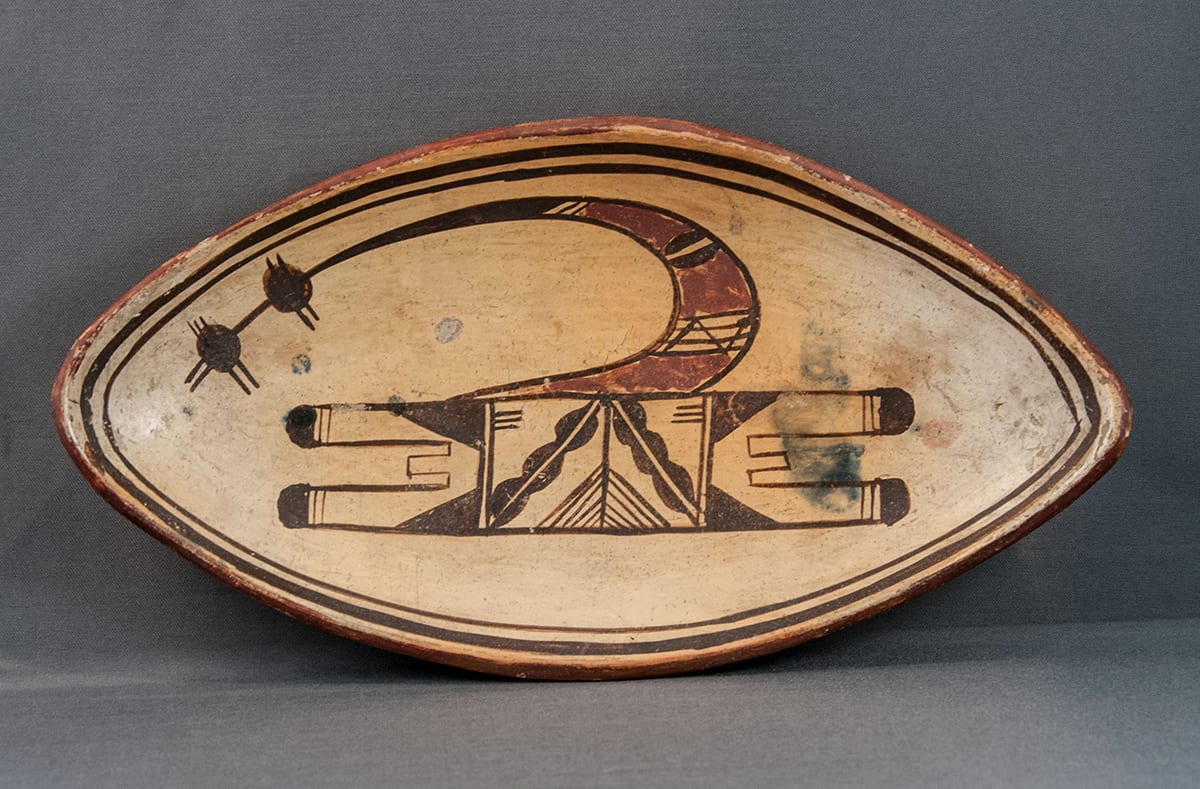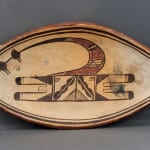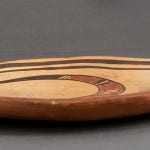The tray does not have a flat rim; the pointed ends curve up slightly. The inside is smoothly polished while the outside shows more definite polishing marks, which run parallel to the long axis of the tray. Such parallel polishing is particularly difficult and time consuming. The piece is well-fired with golden blushed tones, particularly on the outside. The shape is unusual.
The rim of the tray is painted red—a holdover from Polacca ware “C” of the 19th Century. A 19th Century bowl by Nampeyo in the collection has a red rim (2009-17), as do many of the Polacca pieces in the collection (see here in the Index of Categories). There are five older 20th century Hopi pots in the collection that are not Polacca ware, but have red rims.
—Bowl 1997-07 was likely made in the first quarter of the 20th century, but its Zuni rain-bird design is a direct reflection of the older Polacca design.
—Salt container 2009-15 is a ritual container with simple decoration, and it probably dates from this same 25-year period.
—Jar 2003-10 is an early Sikyatki Revival pot with a red rim but its design is unusually abstract and is not a standard Revival motif.
— Eccentric pitcher 2012-08 with red lip and fox by Nampeyo was perhaps made about the time of her first residence in Hopi House at the Grand Canyon in 1905.
—Finally, the ovoid tray described here (2012-06) is the only pot other than 2012-08 with a red rim and a classic Sikyatki Revival design. (“Bird Hanging from Sky Band” design.) For other pots with this design, see here in the Index of Categories.) The red rim on this pot suggests that the seller was correct and the piece was probably made in the first quarter of the 20th century.
Note: There are two newer Hopi-Tewa pots in this collection with red rims and Sikyatki Revival designs. One (2007-17) is a huge reproduction by Rachel Sahmie of a Nampeyo pot made before 1907. The other is a small, modest pot made by Rachel’s brother Randall (2008-14).
Typical of Sikyatki Revival pots, the design on 2012-06 is framed by thick-over-thin black lines.
As I detailed in Appendix B, the basic design on tray 2012-06 can be directly traced to a famous prehistoric Sikyatki bowl whose decoration became a favorite design of Nampeyo and shaped her painting style. There are two Nampeyo pots in this collection with the “Bird Hanging from Sky Band” design (1993-04 and 2010-11).
The painting on this ovoid tray is clearly not by Nampeyo, but just as Nampeyo reduced the design to its essential elements to fit the circular face of a small canteen, the maker of tray 2012-06 simplified the same design motif to fit the unusual and constrained space on the surface of this tray. Both painters omitted the usual red half-moon base that generally occupies a good 25% of the design space. On canteen 2010-11, Nampeyo also omitted most of the body of the avian design, but incorporated some body elements into the curvilinear neck. In the case of 2012-06, the maker has kept the base of the body and drawn the curvilinear neck, but omitted the “butterfly” or “shrine” element that is generally found between the two body elements. Although they made different design decisions, the simplification of the original design allowed both Nampeyo and the painter of 2012-06 sufficient space around the design so that each decoration floats unencumbered in the available space.
Generally, (but not always) the base design of this motif has a larger number of linear tails near the thin end of the curvilinear element than it does on the other end. On 2012-06, the linear base of the design is symmetrical and therefore a bit static. Generally the linear tails are all the same length, but here the top and bottom tails are the same length with rounded, dark tips while the middle element is different: shorter, square-ended, and simply outlined.
The elements and painting of the curved “neck” has all the classic features used by Nampeyo: the base of the curve is painted differently than the rest of the curve, and the design incorporates the “split cloud” design and ends in balls and lines that may represent prayer feathers (bahos). Unlike the treatment of this design by Nampeyo, however, the curved design on 2012-06 simply sits on the rectangular base and does not grow out of it organically.
This dish has an interesting unity: an abstract avian design floating within an egg-shaped space.




